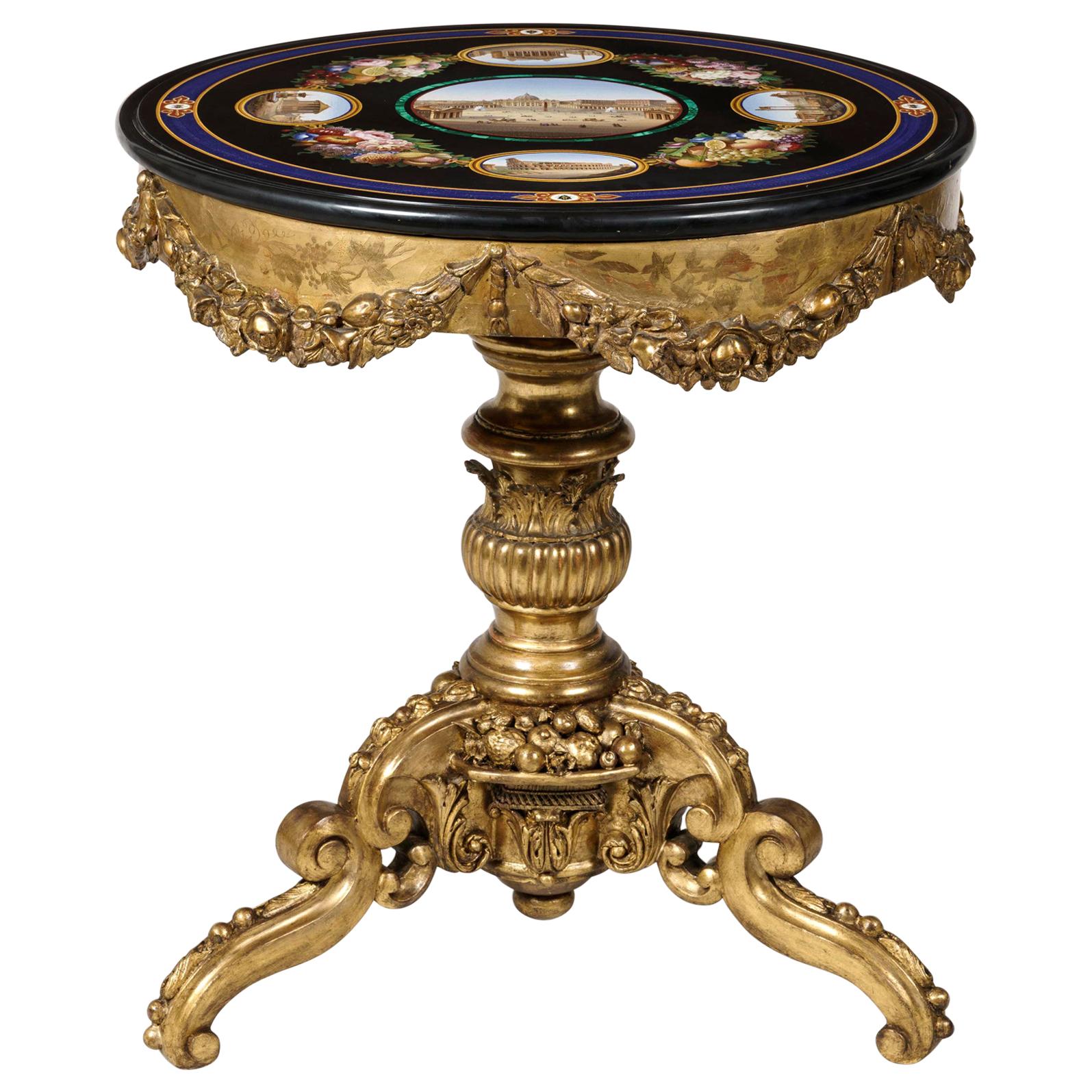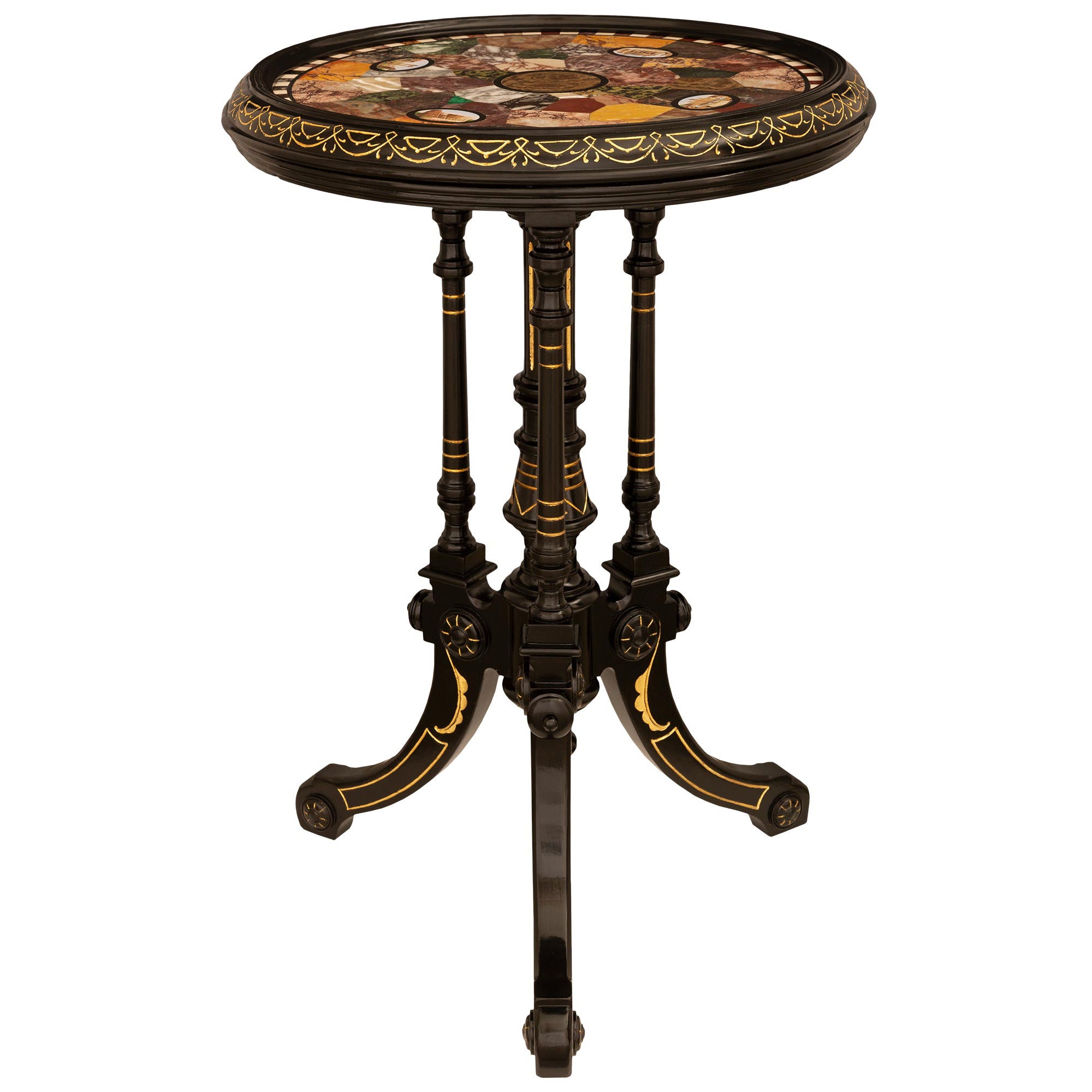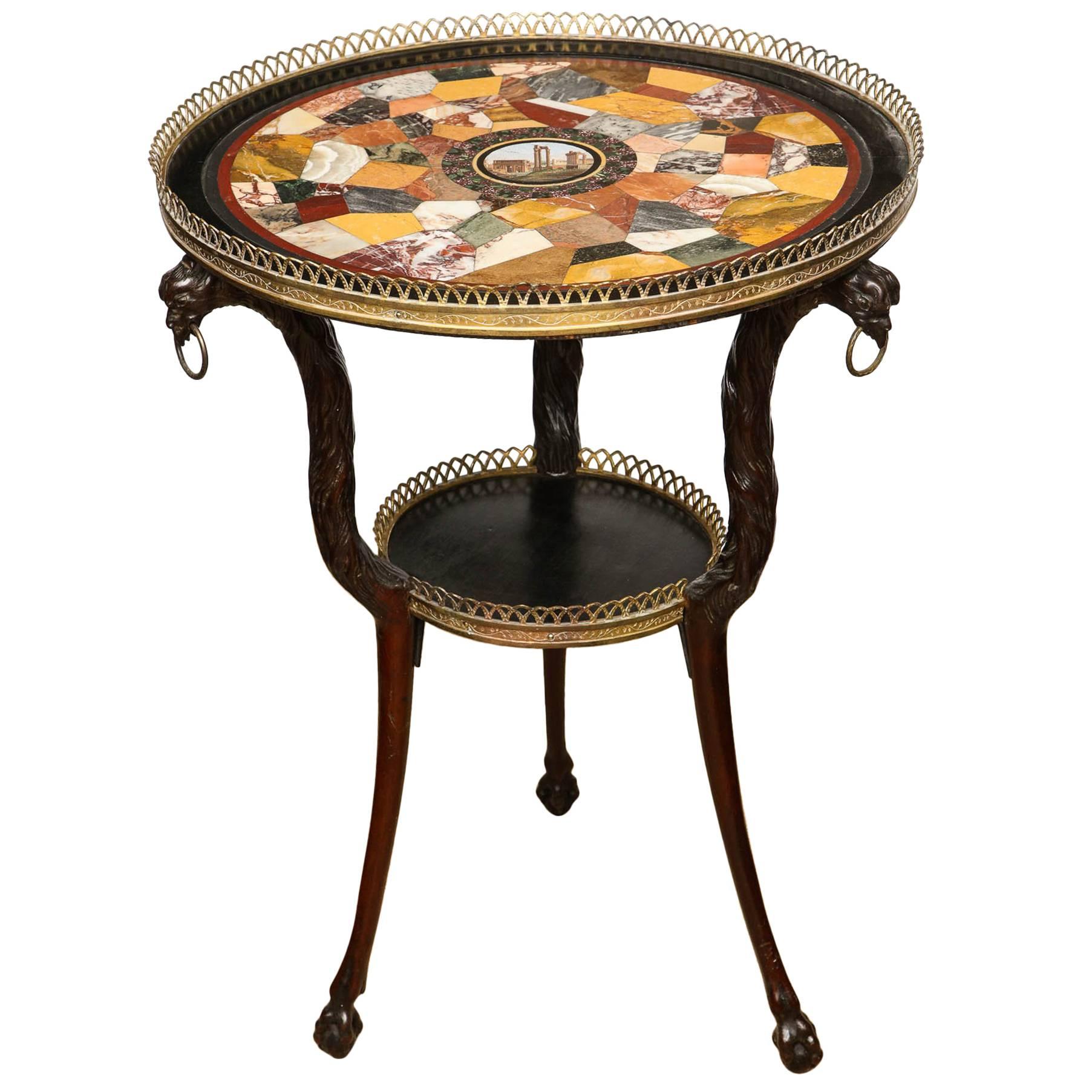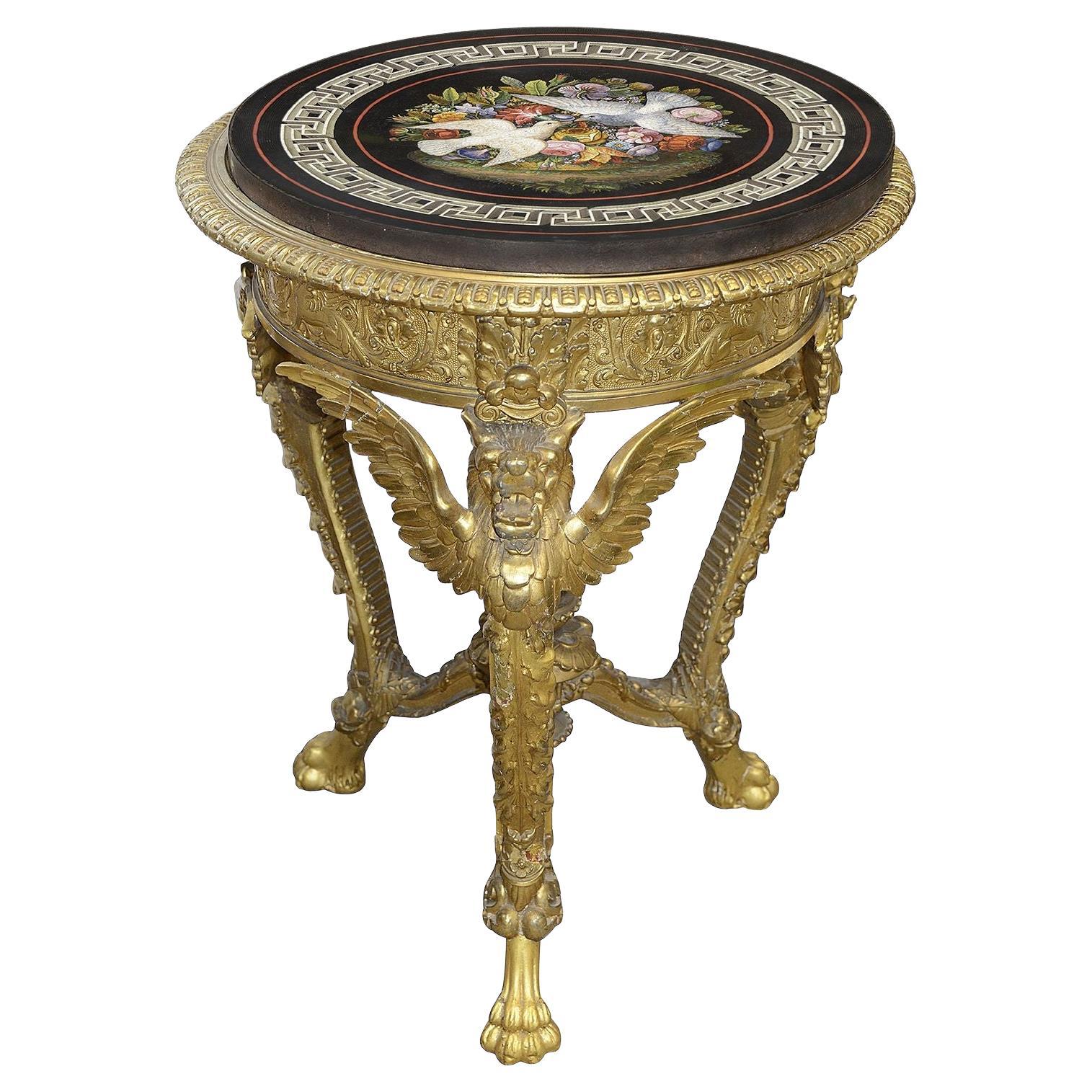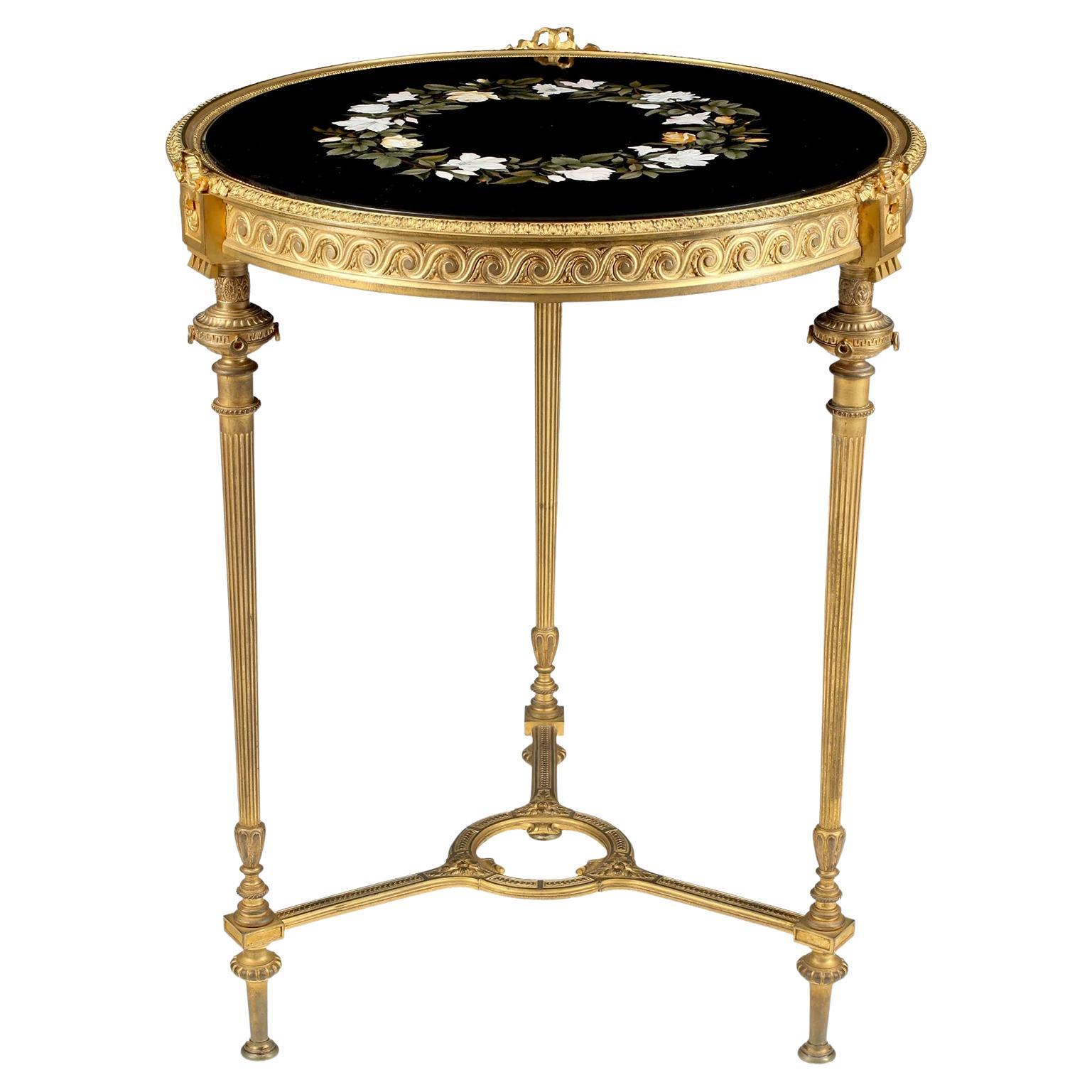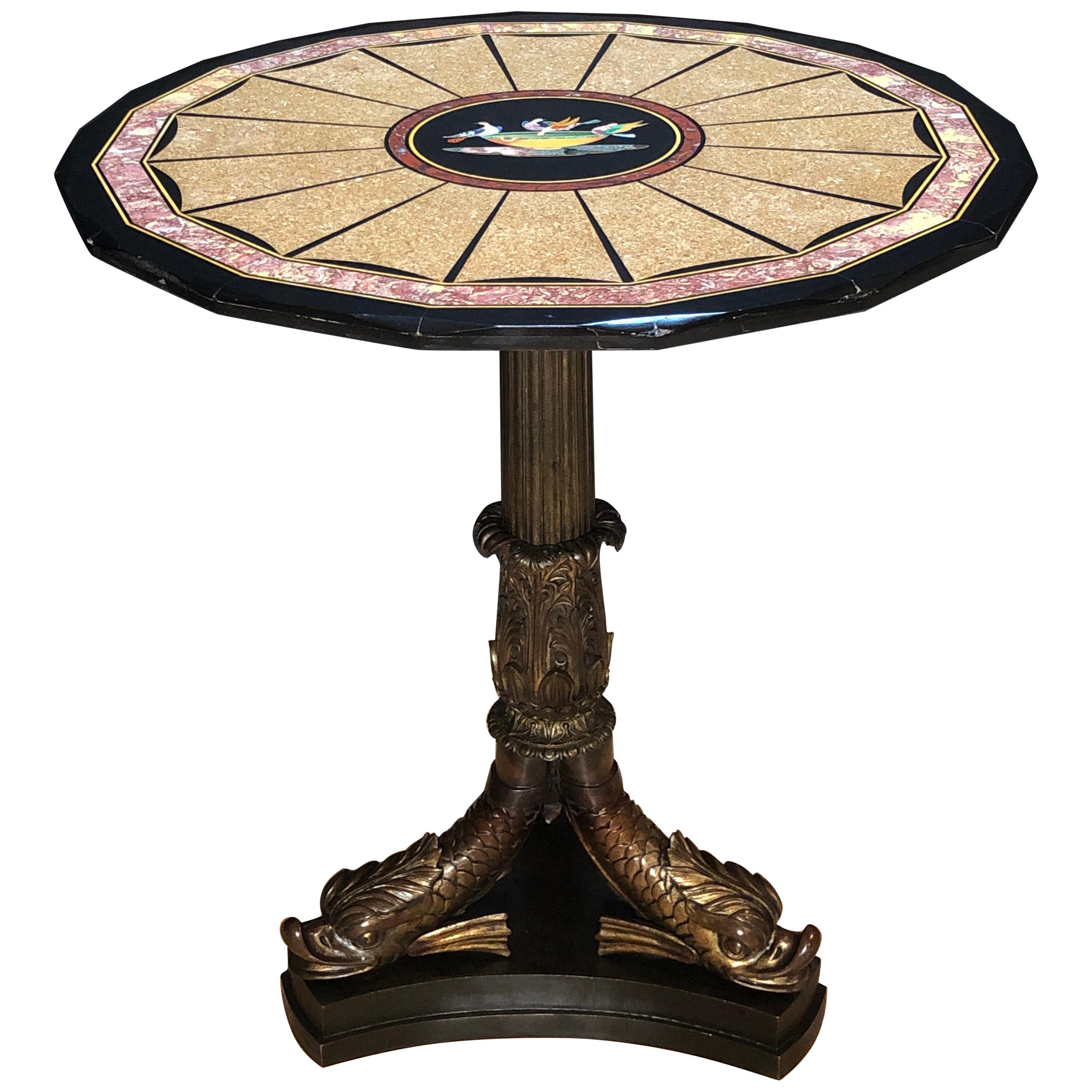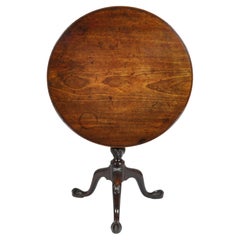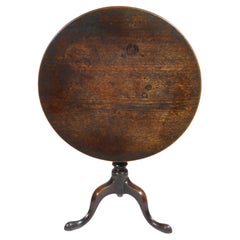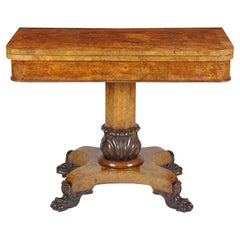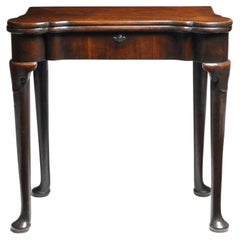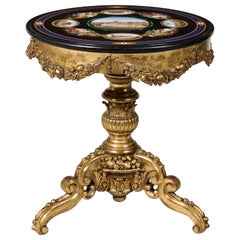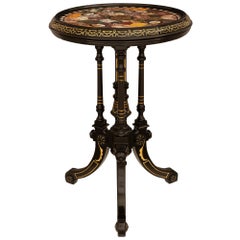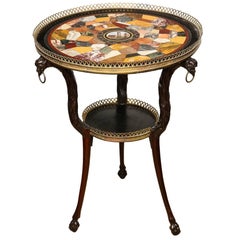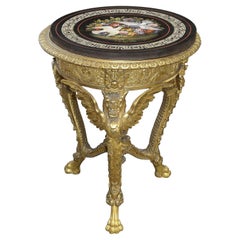Items Similar to A Regency Period Gilt and Ebonised Specimen and micro Mosaic Centre Table
Want more images or videos?
Request additional images or videos from the seller
1 of 6
A Regency Period Gilt and Ebonised Specimen and micro Mosaic Centre Table
$63,224.70
£46,000
€53,817.44
CA$87,126.80
A$95,882.16
CHF 50,279.44
MX$1,163,619.04
NOK 628,485.15
SEK 595,001.35
DKK 401,774.02
About the Item
An amazing Regency period gilt and ebonised centre table with a specimen marble and micro-mosaic top.
The wonderful top is built up out of a plethora of different marbles and stones all mosaiqüed together and banded by a border made of 44 different marble specimens, including samples of lapis lazuli, red and green porphyry, several types of onyx, jasper, breccia and many others.
In the centre of the top sits a micro-mosaic panel depicting in detail the ruins of the Roman forum bordered by a slate and malachite band.
The top sits on a wonderful anthemion decorated frieze on a fluted column and tripartite base decorated with a greek key finished on scroll feet.
The wonderful base still retains its original decoration.
Depicted within the micro-mosaic from left to right
Displayed on the left
The Arch of Septimius Severus is at the northwestern end of the Roman Forum is a white marble triumphal arch dedicated in 203 AD to commemorate the Parthian victories of Emperor Septimius Severus and his two sons, Caracalla and Geta, in the two campaigns against the Parthians of 194-195 and 197–199.
After the death of Septimius Severus, his sons Caracalla and Geta were initially joint Emperors. Caracalla and Geta were assassinated in Rome, in the practice now known as damnatio memoriae. Geta’s memorials were destroyed and all images or mentions of him were removed from street buildings and monuments. Accordingly, Geta’s image and inscriptions referring to him were removed from the arch.
Displayed in the centre
The Temple of Castor and Pollux is an ancient temple. It was originally built in gratitude for victory at the Battle of Lake Regillus(495 BC). Castor and Pollux (Greek Polydeuces) were the Dioscuri, the “twins” of Gemini, the twin sons of Zeus (Jupiter) and Leda. Their cult came to Rome from Greece via Magna Graecia and the Greek culture of Southern Italy.
Displayed on the right
The Temple of Jupiter Optimus Maximus, Temple of Jupiter, the Best and Greatest’), was the most important temple in Ancient Rome, located on the Capitoline Hill. It was surrounded by the Area Capitolina, a precinct where numerous shrines, altars, statues and victory trophies were displayed.
- Dimensions:Height: 30.25 in (76.84 cm)Diameter: 33 in (83.82 cm)
- Style:Regency (Of the Period)
- Materials and Techniques:Agate,Alabaster,Amethyst,Belgian Black Marble,Breccia Marble,Gesso,Giltwood,Gold,Gold Leaf,Lapis Lazuli,Machiche,Malachite,Onyx,Porphyry,Quartz,Stone,Ebonized,Gilt,Hand-Carved,Hand-Painted,Mosaic,Other,Turned,Woodwork
- Place of Origin:
- Period:
- Date of Manufacture:1820
- Condition:Wear consistent with age and use.
- Seller Location:London, GB
- Reference Number:Seller: REF 20201stDibs: LU10143242449292
About the Seller
No Reviews Yet
Vetted Professional Seller
Every seller passes strict standards for authenticity and reliability
Established in 2021
1stDibs seller since 2024
- ShippingRetrieving quote...Shipping from: London, United Kingdom
- Return Policy
Authenticity Guarantee
In the unlikely event there’s an issue with an item’s authenticity, contact us within 1 year for a full refund. DetailsMoney-Back Guarantee
If your item is not as described, is damaged in transit, or does not arrive, contact us within 7 days for a full refund. Details24-Hour Cancellation
You have a 24-hour grace period in which to reconsider your purchase, with no questions asked.Vetted Professional Sellers
Our world-class sellers must adhere to strict standards for service and quality, maintaining the integrity of our listings.Price-Match Guarantee
If you find that a seller listed the same item for a lower price elsewhere, we’ll match it.Trusted Global Delivery
Our best-in-class carrier network provides specialized shipping options worldwide, including custom delivery.More From This Seller
View AllA Fine George III Period Mahogany Tripod Table
Located in London, GB
A George III tripod table of wonderful proportions and great untouched colour.
The crisply carved spiral fluted stem ending in a tri-foot with acanthus carving on the knees terminat...
Category
Antique 18th Century English George III Tables
Materials
Mahogany
A George III Period Mahogany Tripod Table
Located in London, GB
A George III tripod table of wonderful proportions and great untouched colour.
This wonderful example of great 18th century design has survived in the most spectacular condition.
H...
Category
Antique 18th Century English George III Tables
Materials
Mahogany
A Late Regency Burr Elm and Oak Cross Banded Card Table
Located in London, GB
A wonderful late Regency burr elm and oak cross-banded card table, of superb colour and patina. The D-shaped top is of exceptional quality burr elm, standing on an octagonal support ...
Category
Antique Early 19th Century English Regency Card Tables and Tea Tables
Materials
Elm, Oak, Burl
A Small Proportioned George II Period Mahogany Tea Table
Located in London, GB
An unusually small, mahogany tea table of extraordinary colour and patina.
The hinged top leaf opens up to a rich mahogany surface, with a lockable second leaf revealing a mahogany ...
Category
Antique Mid-18th Century British George II Card Tables and Tea Tables
Materials
Mahogany
A Pair of Regency Period X-Framed and Ebonised Oak window Seats
Located in London, GB
Each with rectangular padded seats upholstered in an antique yellow linen fabric. On moulded X-framed legs, joined by baluster stretchers ending on leaf wrapped feet.
These Seats ar...
Category
Antique 19th Century British Regency Chairs
Materials
Linen, Oak
The ST. Giles House Stool
Located in London, GB
This fine hall stool with solid mahogany dished seat having on each side a fluted scroll terminal finished with stylistically carved floral paterea, above carved rails with square ca...
Category
Antique Early 19th Century British Regency Stools
Materials
Mahogany
$19,929
You May Also Like
19th Century Italian Micro-Mosaic Grand Tour Table Attributed to Roccheggiani
By Cesare Roccheggiani
Located in London, GB
A rare grand tour table
Possibly by Cesare Roccheggiani
The circular platform of marmore nero, inset with fine micromosaic panels consisting of thousands of coloured glass tesserae; a central roundel depicting The Vatican from St Peter's Square within a malachite border, surrounded by a border including four cartouches in polychrome reserves of Roman views including the Coliseum, the Roman Forum, with the remnants of the Temple of Vespasian; the Temple of Vesta, and the Pantheon, all interspersed and linked by voluminous bouquets of fruit and flowers representing the 4 seasons; the outer stylised border inlaid with deep blue tesserae evocative of exotic Lapis Lazuli. Supported on a finely carved Italian giltwood base, its design incorporating baskets of fruit and floral garlands echoing the 4 seasons theme of the table.
Italian, Circa 1875
Other table tops inspired by this design, although not as finely executed, can be found in several Russian collections (which house the greatest micromosaics) including Vorontsov Palace, Muranovo House, as well as the imperial State Hermitage Museum. A tabletop with profuse floral micromosaic work was commissioned by the Belgian Royal family (sold Sotheby's, 2003).
The floral garlands, the magnificent quality of the inlay and the use of distinct curved tesserae support the present attribution to Cesare Roccheggiani. According to Jeanette Hanisee Gabriel, the world expert on micro mosaics, curved tesserae pieces were used in foliage, grass and animal fur by only the very best mosaicists such as Roccheggiani. Evidence of curved pieces, for instance, is observed in the foreground of the Temple of Vesta cartouche, to name but one observation of the master's hand.
The scion of a dynasty of mosaicists, Roccheggiani was perhaps the most successful mosaicist in the last quarter of the nineteenth century. He is doubtless related to Lorenzo Roccheggiani, a late eighteenth-century master mosaicist at the Vatican, whose work included the altarpiece, Crucifixion of St. Peter after Guido Reni. Nicolo Roccheggiani, possibly Lorenzo's son, was also a principle artist at the Vatican, involved in executing the famous tabletop Achilles Shield...
Category
Antique 19th Century Italian Grand Tour Center Tables
Materials
Malachite, Marble, Belgian Black Marble
Italian 19th Century Renaissance St. Specimen Marble And Micro-Mosaic Side Table
Located in West Palm Beach, FL
A most decorative Italian 19th century Renaissance st. Ebonized Fruitwood, Specimen marble and Micro-Mosaic side table. The table is raised on a tripod base with three 'C' scrolled l...
Category
Antique 19th Century Italian Renaissance Side Tables
Materials
Marble
Austrian Neoclassical Gueridon with Micro Mosaic and Specimen Marble Top
Located in Greenwich, CT
Very Fine Austrian Neoclassical gueridon table with gilt brass pierced gallery, the specimen marble top with Roman micro-mosaic center depicting ruins, hav...
Category
Antique 1830s Austrian Biedermeier Gueridon
Materials
Marble
19th Century Italian Micro Mosaic Table
Located in Brighton, Sussex
A fine quality 19th century Italian Micro Mosaic marble top gueridon, depicting a pair of Doves among exotic flowers with a classical Greek pattern boarder, Set in this wonderful han...
Category
Antique 19th Century Italian Center Tables
Materials
Marble
Franco-Italian 19th Century Neoclassical Style Gilt-Bronze & Pietra Dura Table
Located in Los Angeles, CA
A Very fine Franco-Italian 19th century neoclassical Revival style gilt-bronze and Pietra Dura (or Pietra-Dure) occasional side-table Gueridon. The circular gilt-bronze frame raised ...
Category
Antique 19th Century Italian Neoclassical Revival End Tables
Materials
Marble, Bronze, Ormolu
$19,600 Sale Price
20% Off
Pietra Dura Specimen Marble and Figural Bronze Center Table
Located in Norwood, NJ
!9th century Regency Pietra Dura specimen marble and figural bronze gueridon center table. Italian Pietra Dura center medallion on specimen marble top seated on a french patinated br...
Category
Antique Mid-19th Century Italian Regency Gueridon
Materials
Lapis Lazuli, Malachite, Marble, Belgian Black Marble, Breccia Marble, B...
More Ways To Browse
Antique Micro Mosaic
Marble Mosaic Table
Black Onyx Table
Gold Leaf Mosaic
Micro Mosaics 19th Century
Antique Carved Amethyst
Greek Scroll
Red Lapis Lazuli
Lapis Lazuli Mosaic
Altar Shrine
Alabaster Hand Painted
Castor And Pollux
Marble Sample
Temple Of Castor And Pollux
Victory Statue
Limestone Round Table
Round Glass Top End Tables
Square Pedestal Wood Side Tables
